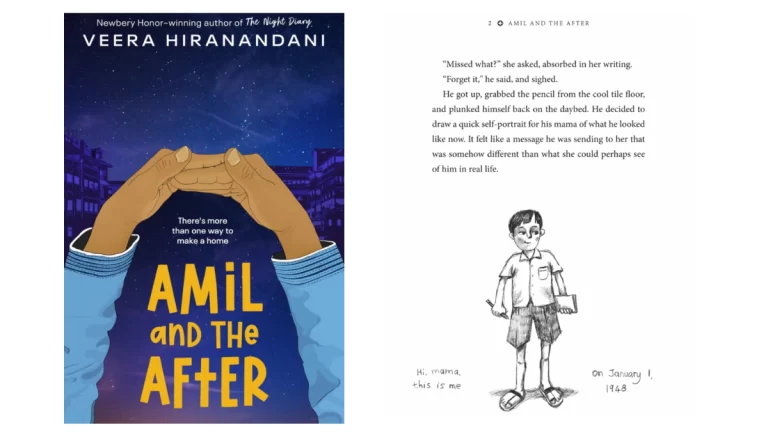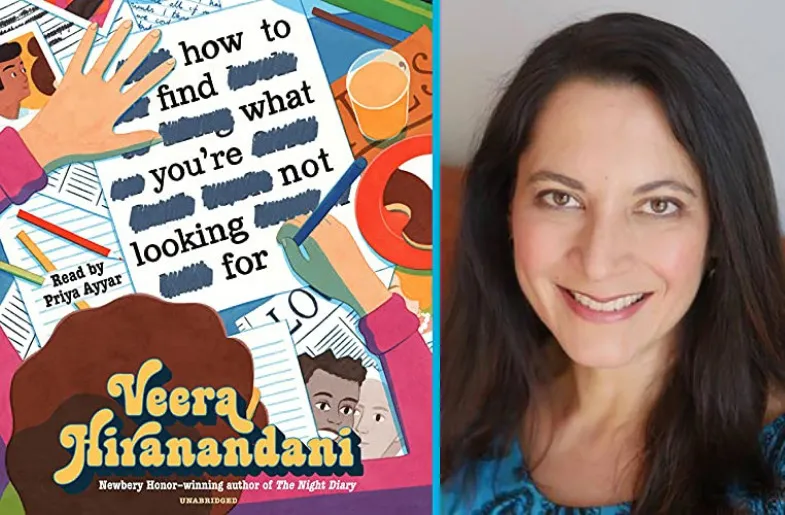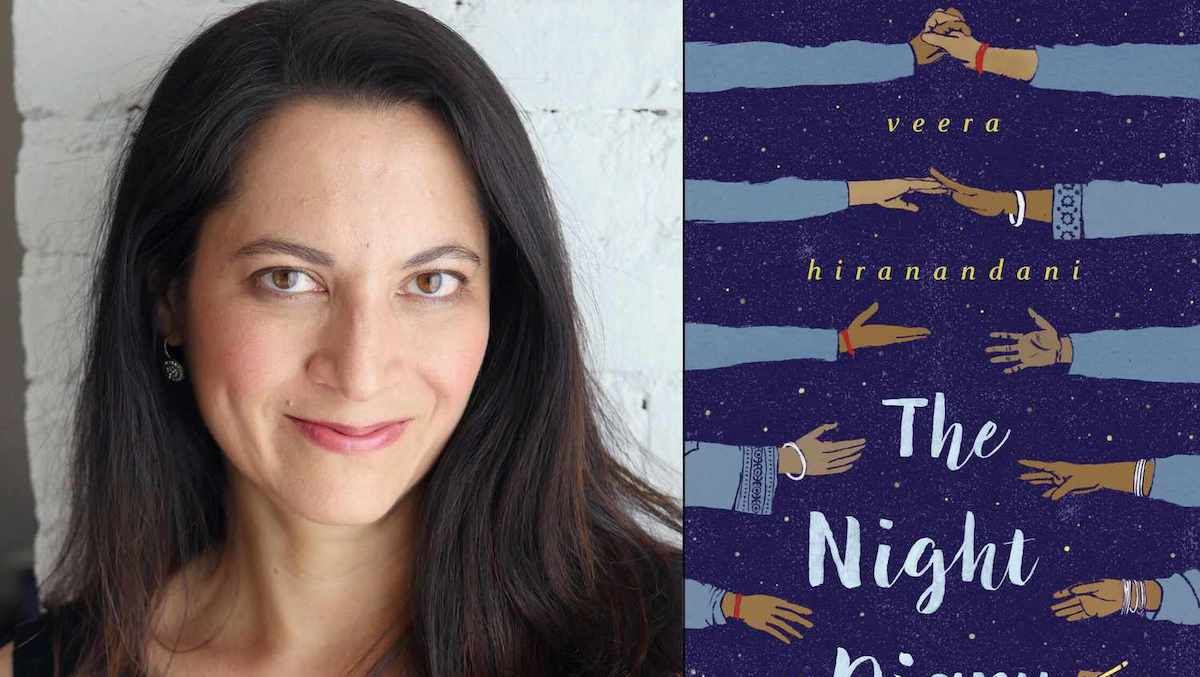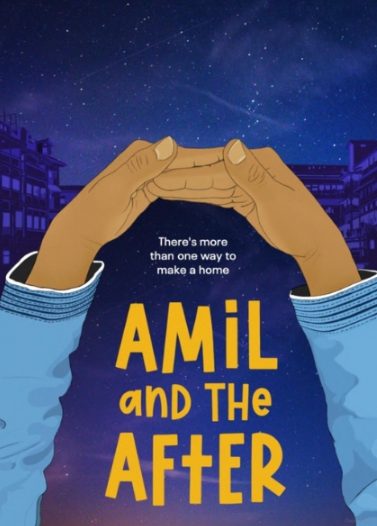
A Sindhi-Hindu Jewish American talks about interfaith relationships, her YA Partition novel and the spirit of pluralism in her family
By Shabnam Arora Afsah
An interview with Veera Hiranandani
Set during the time of the partition of the Indian subcontinent, Veera Hiranandani’s YA novel, The Night Dairy, narrates the journey of a nine-year-old Sindhi boy named Amil from his ancestral land of Sindh (now in Pakistan) to the newly formed independent India. This brilliantly written piece of historical fiction won her many awards, including the prestigious Newbury Honor in 2019.
Read: New Novel for Younger Readers Explores Interracial Marriage and Anti-Semitism
In her recently released sequel, Amil and The After, she continues the story of Amil and his twin sister, Nisha; she describes how they cope with the trauma of displacement and the challenges that come with trying to adjust to a new life in their small flat in Bombay. As the daughter of two Partition survivors, I was indeed intrigued by Hiranandani’s focus on this brutal history of our subcontinent while writing for children (aged 8-12). Recently I talked with her about not just her unusual choice of topic but also about how the two novels draw upon the experiences of her father’s family.
Read: Amil And The After Explores How The Partition Affected Children
 Shabnam Arora Afsah: Congratulations on the release of your new novel, Amil and The After. I really enjoyed the book. I was wondering what motivated you to write about this very adult subject in a novel meant for young adults (aged 8-12)?
Shabnam Arora Afsah: Congratulations on the release of your new novel, Amil and The After. I really enjoyed the book. I was wondering what motivated you to write about this very adult subject in a novel meant for young adults (aged 8-12)?
Veera Hiranandani: I think it’s important to address what are generally seen as adult topics in children’s literature. This is so because children’s lives are not independent of adult lives. They experience the repercussions of political, emotional, or financial upheavals just as adults do. When children are forced to move from their ancestral lands, when they become refugees elsewhere, or they face war and ethnic cleansing, or when they face racism and xenophobia, they must deal with trauma much the same way as adults do. I strongly feel that children’s books should reflect their own life experiences or inform them about the challenges others face.
Shabnam: What is your own family’s connection with the Partition of India and Pakistan?
Veera: My father’s family was originally from Sindh, from a town called Mirpur Khas. At the time of the Partition, they followed a journey very similar to the fictional family in my books. They first traveled to Jodhpur by train and then eventually moved to Mumbai.
Shabnam: How did you learn about your family’s past?
Veera: My father came to the U.S. in his twenties, and I was born much later, but he often talked about what his family had endured during the Partition.
Shabnam: How old was your father at the time of the Partition?
Veera: He was only nine years old, so his memories of what he observed are very child-like.
Shabnam: Tell me a little about your own upbringing.
Veera: I was born and raised in a small town in Connecticut. As I said, my father is from a Sindhi Hindu family, and my mother was from a Jewish American family, and they got married in the 1960s. While growing up, I came across very few Indian American families or even Jewish families, certainly none that were both.
Shabnam: How much of your novel is based upon the experiences of your father and his family members?
Veera: My story is set in an apartment in Colaba, on 1st Pasta Lane. My father’s older sister lived in the apartment where I have placed my fictional family in. As a child, I heard stories from my uncles and aunts about how they had to leave their ancestral home, and how difficult it was for them to adapt to the new life after they lost everything. In Mirpur Khas, they were an affluent family and lived in a large compound. In a way, it’s easier for my father to talk about it because he was just a kid, and he followed the rest of his family without questioning the choices made by the elder members. Fortunately, my grandparents did not face any direct violence. I guess, if my father had been the victim of violence or observed it in person, he might have sustained more trauma.
Shabnam: Is the character of Amil based on your own father?
Veera: Absolutely!
Shabnam: I’m curious about how Amil came to have a Muslim mother? That was certainly an unusual element in the story.
Veera: That part is fictional, but I based it on stories I had come across in my research. Such marriages were rare, but some did take place. By portraying Amil’s mother to be Muslim I wanted to add another layer of complexity to his identity, but I did not keep her as a living character; that detail would have made the story a little difficult.
Shabnam: In several instances, the religious identity of your characters was revealed slowly; for instance, Vishal professed to be Hindu, and told Amil and Nisha that he had come to India on a boat with another Hindu man. Later he revealed that he was from a Muslim family. My interest was piqued by this unusual detail – why would a Muslim boy cross the border and come to India? Again, Mrs. Chatwani turned out to be Muslim but married to a Hindu man.
Veera: Yes, I wanted to highlight that in these chaotic times, not everything was obvious or black and white. In my research I came across instances in which people were either forced to convert to another religion or they pretended to be from another religion just to be able to survive.
Shabnam: Many parts of your story resonated with me. I chose to marry someone who was not from my religion. I also have friends who are in interfaith relationships. I even knew of a couple where the man was from a Bengali Hindu family and his wife was Jewish. Have you ever heard the term Hinjew?
Veera: Yes, of course. Even though my parents brought us up in a very secular atmosphere, I suppose my family would count as being Hinjew. My extended family on both sides were much more observant. The cousins on my father’s side of the family were brought up in a practicing Hindu household, and they spoke Hindi and Sindhi, while I don’t understand either of those languages.
Shabnam: Would you say you are more culturally Hindu and culturally Jewish, rather than observant Hindu or observant Jewish?
Veera: Definitely. But since my mother’s parents lived close to us, I was much more engaged with my Jewish background. My father’s parents died before he came to the U.S., so their absence in my life clearly had some effect. My father was close to his older brothers, who came to the U.S. before he did. Maybe that is what was behind my interest in discovering my Indian roots. Even though I don’t actively practice its traditions, I’ve studied Hinduism.
Shabnam: Did you ever travel to India while you were growing up?
Veera: I went once as a teenager. Then a few more times as an adult.
Shabnam: Who is your target audience for these two novels? Are these books meant for Indian American children?
Veera: Of course, Indian American children could learn about their roots through my novels but, I don’t want my books to be restricted to that community only. Academic curricula in most American schools do not give our children the opportunity to learn about the history of that part of the world. I know that growing up, I myself had many unanswered questions.
For instance, when the movie Gandhi came out, I questioned how we had never heard of the Partition when it was such an important part of global history? Since I had not learned about it in school, I had not made the connection of this huge historical event with the lives of my immediate family members. Finally, when I made that connection, it was really eye-opening. I wanted to know all about it – why did it happen, why couldn’t it have been prevented, or when the line of demarcation was drawn by the British, why did it so quickly become as chaotic as it did?
Later I read about communities that used to be very accepting of communal or religious differences. There seemed to be a spirit of pluralism and there were overlapping customs followed by families of different religions, particularly, in cases where the families were either Sikh or Hindu.
While they lived in the U.S., on Diwali my uncle’s family would visit the Sikh temple. And I remember, occasionally my own family would join them on the visits to the Gurudwara. As a child, I was probably a little confused about how I was Jewish, but somehow, I was also Hindu and sometimes we went to a Sikh temple.
 When I grew up, I had a lot of weighty questions – why did the Partition take place? Why did people who got along with one another then turn against each other? I didn’t know then that I’d grow up to be a writer but when I decided to write I wanted to write about these subjects from a child’s perspective.
When I grew up, I had a lot of weighty questions – why did the Partition take place? Why did people who got along with one another then turn against each other? I didn’t know then that I’d grow up to be a writer but when I decided to write I wanted to write about these subjects from a child’s perspective.
Shabnam: I noticed in your writing that at times both Amil and his sister, Nisha, have very adult-like ideas. Initially, I thought that the writing didn’t seem to be written in a child’s voice. But as I got deeper into the book, I saw that you were trying to convey the effect of emotional trauma on a child’s psyche and how such trauma can force one to mature at an accelerated pace.
I loved the indirect ways in which you demonstrated the effects of this trauma on the two children. Nisha became more quiet, withdrawn, and inward-looking, whereas Amil’s reaction made him a little belligerent or stubborn at times. He vented his emotions through his sketches and drawings, while Nisha secretly wrote stories. At times I also thought that Amil was probably a little dyslexic. Was I reading too much into it or did you mean to portray him as being dyslexic without overtly stating that?
Veera: Yes, Amil is dyslexic. I did not really label it, but I felt that people who know about learning disabilities will recognize it. As a child, I used to love to draw sketches and write stories. This helped me discover who I was and how to express myself through art. In a way, I feel that I’m a combination of Amil and Nisha.
Shabnam: Yes, I felt that adding such facets to your characters’ personalities layered your writing extremely well and brought the characters to life. I loved how the coping mechanisms of two children were vastly different, and yet they were very close to one another.
Veera: The two differed in other ways too. Societal expectations are quite different for boys and girls and in some ways, Amil and Nisha’s reactions were tailored in reaction to such expectations.
Shabnam: I would really like to know more about your process of writing. How do you go about your research and how do you incorporate this research into the plot of the story?
 Veera: At the very beginning my method began in an unstructured fashion. I started by talking to family members, my father, his sister, and a good friend of my father’s, whose family had lived in a refugee camp in Bombay for an extended period. Apart from these personal stories, it was very helpful to read the narratives of survivors documented by 1947 Partition Archives in Berkley. There I was able to read hundreds of personal histories from a very wide array of perspectives.
Veera: At the very beginning my method began in an unstructured fashion. I started by talking to family members, my father, his sister, and a good friend of my father’s, whose family had lived in a refugee camp in Bombay for an extended period. Apart from these personal stories, it was very helpful to read the narratives of survivors documented by 1947 Partition Archives in Berkley. There I was able to read hundreds of personal histories from a very wide array of perspectives.
I also read several academic books. Among them, my favorite is “The Great Partition” by Yasmin Khan. I also relied on Saaz Aggarwal’s, “The Amils of Sindh,” and Nandita Bhavnani’s book, “The Making of Exile: Sindhi Hindus and The Partition of India.”
Apart from these, newspaper articles from the weeks and months that I covered in my novel were helpful in creating the context. Finally, I had to transfer all the details and data I had gathered to a more human experience, so I could make the lives of my fictional characters seem believable.
In a way, I was creating a generic Partition experience and in other ways, I was conjuring up a very particular Partition experience. I was trying to balance between the two because I wanted the characters to reflect the internal strife that must have arisen in the minds of the children, such as – “Who am I? Where do I belong in these polarized societies and divided countries?”
Shabnam: Your process sounds a lot like my struggle while writing my own novel set against the backdrop of the Partition. I spent five years researching and when it came to writing the actual story, I realized the focus needed to be entirely on the daily lives of my characters. In the end, the extensive research set an invisible foundation upon which I built my story. For me, trying to embed the historical details I had gathered was like a tightrope walk. I struggled with finding the right balance between providing just enough details to effectively frame the historical context and including too many details, which made the story appear contrived. In the end, to keep the spotlight on my characters, I deleted a lot of extraneous material.
Veera: You said it very well. It is hard to strike a balance between history and fiction. Especially, in this second novel, I had to set up the context for those who hadn’t read the previous novel, The Night Diary, in which I had introduced all these characters and described what they went through at the very beginning of their journey from Mirpur Khas. So, the initial summarizing in this novel was warranted because I wanted the reader to understand the context in case, they weren’t familiar with the characters and their story.
Shabnam: I also wanted to ask you how audiences other than South-Asians have received the novel. On the one hand, the story is very rooted in the history of our subcontinent, where India-American kids or Pakistani-Americans could relate to it but on the other hand, it describes a very universal experience of mass displacement and forced human migration. Your books are very pertinent and timely because the younger generation is now observing in real-time how war affects the lives of others. They are seeing the effects of the ongoing war in Ukraine, or what is unfolding in Gaza, and what recently took place in Syria. Human history is replete with examples of large-scale displacement.
Veera: So far, it’s been received very well. I’ve gotten some good reviews by South-Asian reviewers. I often hear from students and educators who do not have South-Asian roots that they knew nothing about the history of the Partition and its violent aftermath, but they appreciate learning about it through my books. I’m not surprised by the lack of knowledge about that part of the world.
I went through my entire schooling in America without a mention of these seismic historical developments that took place in the post-World War II era.
In our global history courses, there was probably a line or two about India’s independence or Pakistan’s creation. I feel that I’ve become a late-blooming student of history. I now try to understand the deeper roots of contemporary conflicts. Just watching television and witnessing the violence and devastation is emotionally painful.
For instance, now with this war in the Middle East, I want to understand the reasoning behind the conflict between the Israelis and Palestinians. I acknowledge that I’m half Jewish, but I also empathize with what the people of Gaza are going through. I want to understand the whys and the hows of what is going on at a human level and I want to do it without any bias.
I constantly think about the children who are affected by these wars, and it’s heartbreaking. The Nisha and Amil in me are always questioning – why are things the way they are? I don’t have any easy answers, but I plan to keep writing to figure it out.
Read: American author Veera Hiranandani – Blend of Sindhi and Jewish Cultures
____________________
 Shabnam Arora Afsah is a writer, lawyer, and short story writer who is working on her first novel based on the Partition of India. She is a committed political activist and also runs a food blog for fun!
Shabnam Arora Afsah is a writer, lawyer, and short story writer who is working on her first novel based on the Partition of India. She is a committed political activist and also runs a food blog for fun!
Courtesy: India Currents (Posted on March 6, 2024)